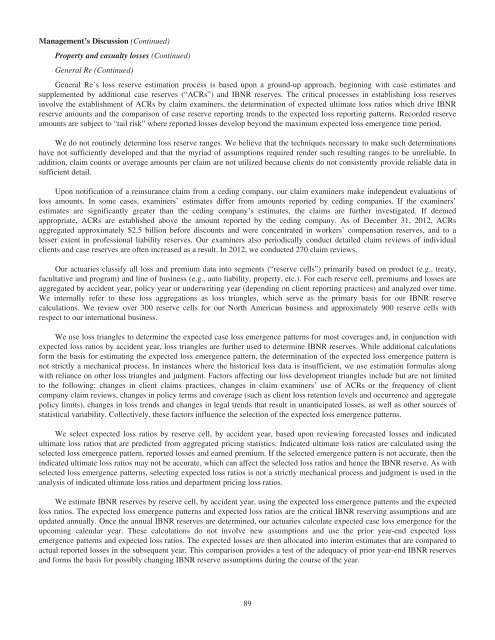BERKSHIRE HATHAWAY
BERKSHIRE HATHAWAY
BERKSHIRE HATHAWAY
Create successful ePaper yourself
Turn your PDF publications into a flip-book with our unique Google optimized e-Paper software.
Management’s Discussion (Continued)<br />
Property and casualty losses (Continued)<br />
General Re (Continued)<br />
General Re’s loss reserve estimation process is based upon a ground-up approach, beginning with case estimates and<br />
supplemented by additional case reserves (“ACRs”) and IBNR reserves. The critical processes in establishing loss reserves<br />
involve the establishment of ACRs by claim examiners, the determination of expected ultimate loss ratios which drive IBNR<br />
reserve amounts and the comparison of case reserve reporting trends to the expected loss reporting patterns. Recorded reserve<br />
amounts are subject to “tail risk” where reported losses develop beyond the maximum expected loss emergence time period.<br />
We do not routinely determine loss reserve ranges. We believe that the techniques necessary to make such determinations<br />
have not sufficiently developed and that the myriad of assumptions required render such resulting ranges to be unreliable. In<br />
addition, claim counts or average amounts per claim are not utilized because clients do not consistently provide reliable data in<br />
sufficient detail.<br />
Upon notification of a reinsurance claim from a ceding company, our claim examiners make independent evaluations of<br />
loss amounts. In some cases, examiners’ estimates differ from amounts reported by ceding companies. If the examiners’<br />
estimates are significantly greater than the ceding company’s estimates, the claims are further investigated. If deemed<br />
appropriate, ACRs are established above the amount reported by the ceding company. As of December 31, 2012, ACRs<br />
aggregated approximately $2.5 billion before discounts and were concentrated in workers’ compensation reserves, and to a<br />
lesser extent in professional liability reserves. Our examiners also periodically conduct detailed claim reviews of individual<br />
clients and case reserves are often increased as a result. In 2012, we conducted 270 claim reviews.<br />
Our actuaries classify all loss and premium data into segments (“reserve cells”) primarily based on product (e.g., treaty,<br />
facultative and program) and line of business (e.g., auto liability, property, etc.). For each reserve cell, premiums and losses are<br />
aggregated by accident year, policy year or underwriting year (depending on client reporting practices) and analyzed over time.<br />
We internally refer to these loss aggregations as loss triangles, which serve as the primary basis for our IBNR reserve<br />
calculations. We review over 300 reserve cells for our North American business and approximately 900 reserve cells with<br />
respect to our international business.<br />
We use loss triangles to determine the expected case loss emergence patterns for most coverages and, in conjunction with<br />
expected loss ratios by accident year, loss triangles are further used to determine IBNR reserves. While additional calculations<br />
form the basis for estimating the expected loss emergence pattern, the determination of the expected loss emergence pattern is<br />
not strictly a mechanical process. In instances where the historical loss data is insufficient, we use estimation formulas along<br />
with reliance on other loss triangles and judgment. Factors affecting our loss development triangles include but are not limited<br />
to the following: changes in client claims practices, changes in claim examiners’ use of ACRs or the frequency of client<br />
company claim reviews, changes in policy terms and coverage (such as client loss retention levels and occurrence and aggregate<br />
policy limits), changes in loss trends and changes in legal trends that result in unanticipated losses, as well as other sources of<br />
statistical variability. Collectively, these factors influence the selection of the expected loss emergence patterns.<br />
We select expected loss ratios by reserve cell, by accident year, based upon reviewing forecasted losses and indicated<br />
ultimate loss ratios that are predicted from aggregated pricing statistics. Indicated ultimate loss ratios are calculated using the<br />
selected loss emergence pattern, reported losses and earned premium. If the selected emergence pattern is not accurate, then the<br />
indicated ultimate loss ratios may not be accurate, which can affect the selected loss ratios and hence the IBNR reserve. As with<br />
selected loss emergence patterns, selecting expected loss ratios is not a strictly mechanical process and judgment is used in the<br />
analysis of indicated ultimate loss ratios and department pricing loss ratios.<br />
We estimate IBNR reserves by reserve cell, by accident year, using the expected loss emergence patterns and the expected<br />
loss ratios. The expected loss emergence patterns and expected loss ratios are the critical IBNR reserving assumptions and are<br />
updated annually. Once the annual IBNR reserves are determined, our actuaries calculate expected case loss emergence for the<br />
upcoming calendar year. These calculations do not involve new assumptions and use the prior year-end expected loss<br />
emergence patterns and expected loss ratios. The expected losses are then allocated into interim estimates that are compared to<br />
actual reported losses in the subsequent year. This comparison provides a test of the adequacy of prior year-end IBNR reserves<br />
and forms the basis for possibly changing IBNR reserve assumptions during the course of the year.<br />
89


